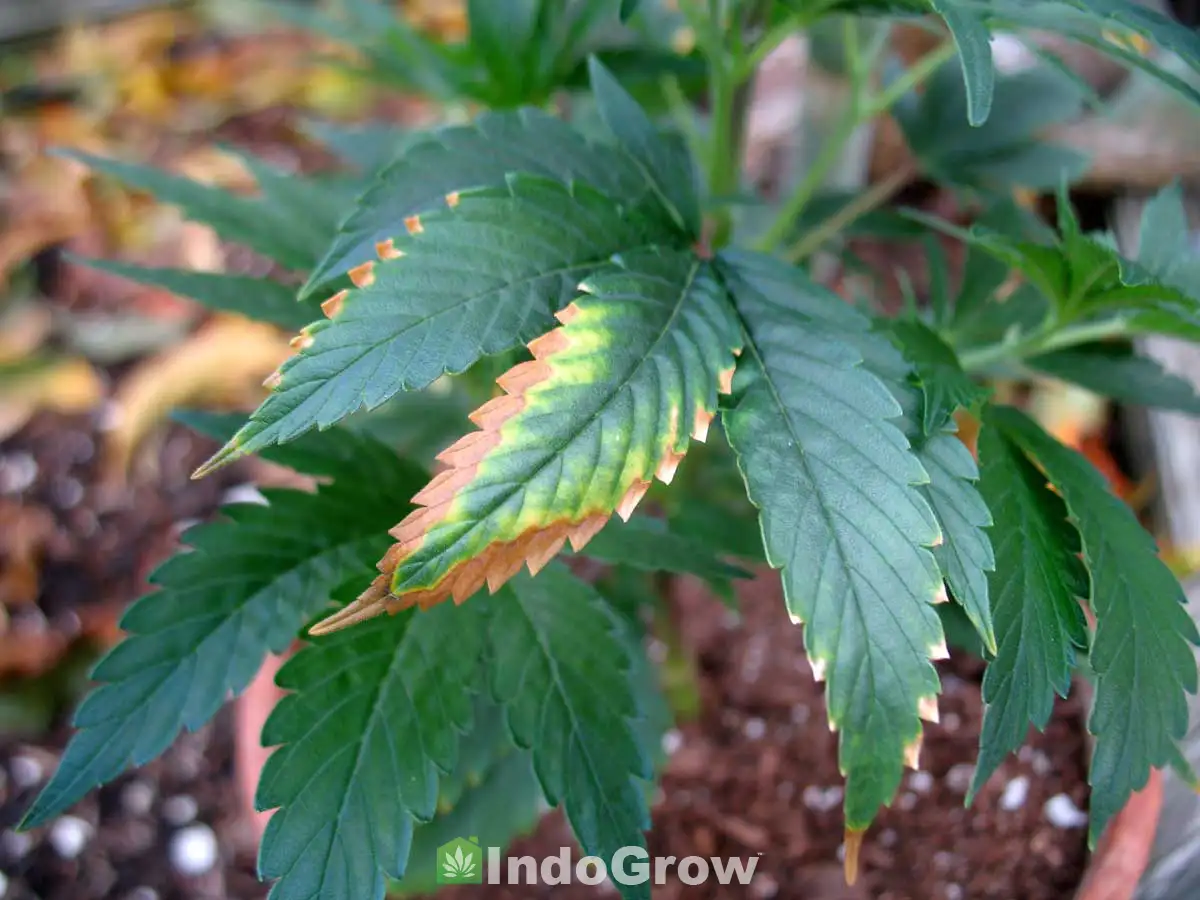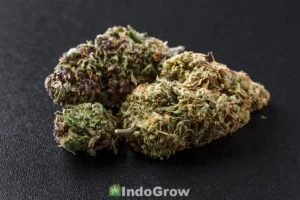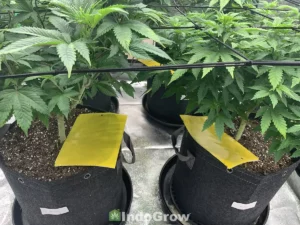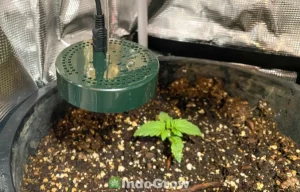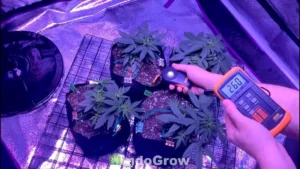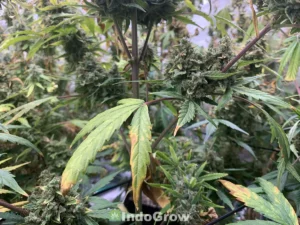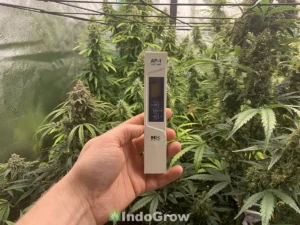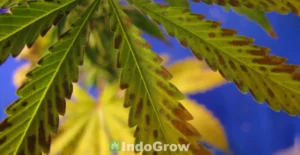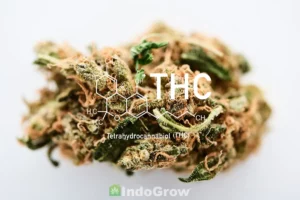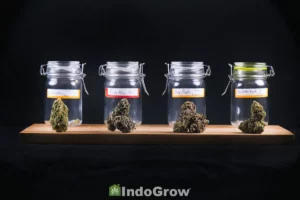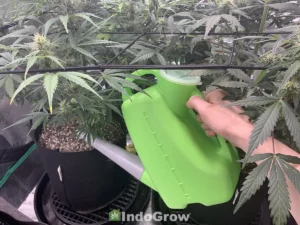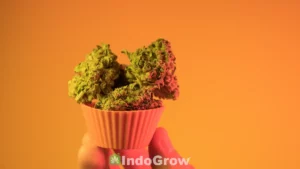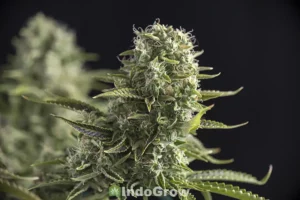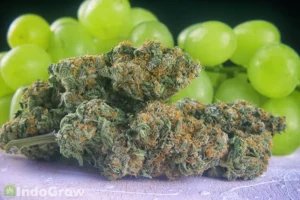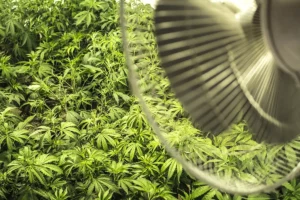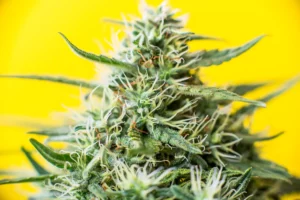Potassium is one of three primary macronutrients consumed by Cannabis alongside nitrogen and phosphorus, and access to adequate supplies of potassium are essential for the health of your cannabis plants.
This article will discuss symptoms of cannabis potassium deficiency and toxicity, followed by tips and product recommendations to get your plants back to full health.
Table of Contents
- What Functions Does Potassium Provide for Cannabis Plants?
- Potassium Deficiency Symptoms in Marijuana
- How Much Potassium to Give Cannabis Plants?
- What is the Proper NPK ratio for Cannabis Plants?
- How to Fix Potassium Deficiency in Cannabis Plants
- Bloom Fertilizers and PK Boosters
- Organic Potassium Sources
- Cannabis Potassium Toxicity Symptoms
- How to Fix Potassium Toxicity in Cannabis
- Conclusion
What Functions Does Potassium Provide for Cannabis Plants?
Cannabis plants use potassium in a variety of metabolic processes including photosynthesis, synthesis of amino acids and proteins, building cell walls, and the movement of carbohydrates and other nutrients throughout the plant. This essential nutrient strengthens plant tissues, increases drought and temperature resistance, strengthens root systems, and more.
Although potassium is important at all stages of the cannabis life cycle, it is consumed in especially large quantities during the flowering phase. Marijuana grown with adequate potassium will produce larger, denser buds with superior scent, flavor, and potency.
Potassium Deficiency Symptoms in Marijuana
Because Potassium is one of the three primary macronutrients needed for cannabis to thrive, potassium deficiency in weed plants can cause significant symptoms including stunted growth, damaged leaves, decreased hardiness, weak flowering, and more. The subheadings below will go into greater detail on symptoms typical during the vegetative and flowering stages.
Vegetative Symptoms of Potassium Deficiency
Although cannabis potassium deficiency is more common during the flowering stage, deficiency symptoms may also occur during the vegetative stage. Symptoms include yellowing and necrosis around the margins of the fan leaves, curling leaf tips, weakened or flimsy stems, and decreased tolerance to temperature changes.
Because potassium is a mobile nutrient, the cannabis plant will begin stripping potassium from older leaves and relocating it to the top of the plant if it cannot collect enough potassium from the growing medium. This causes potassium deficiency symptoms to commonly appear first on the oldest leaves on the bottom of the plant, before slowly moving upward as the deficiency progresses.
Since cannabis plants consume relatively little potassium during the vegetative stage, acting quickly to increase potassium levels is essential to protect your yield. If the potassium deficiency is corrected before flowering begins, buds should form normally.
Flowering Symptoms of Potassium Deficiency
Cannabis potassium deficiency most commonly appears during the flowering stage, when the plant begins consuming greater quantities of potassium. Similar to vegetative symptoms, the plant will likely have damage to lower leaf edges and overall decreased vitality. The interior veins of the leaf typically stay green while the edges appear burnt.
In addition, potassium deficiency during the flowering stage can cause flowers to be unusually small and slow growing, with less aroma and color than normal. Some people have reported excessive stretching due to potassium deficiency. If the deficiency is caught and corrected during the early weeks of flowering, plants will often recover and produce a closer to normal yield.
How Much Potassium to Give Cannabis Plants?
In commercial growing operations, cannabis plants are typically fed between 150-215 ppm (parts per million) of potassium in their water supply. This study published in Frontiers in Plant Science suggests that a wide range of ppm values can produce a visually healthy cannabis plant, although staying between 50-200 ppm appeared to produce the best results. Although cannabis plants do not necessarily need potassium levels over 50 ppm to survive during the vegetative stage, cannabis is capable of banking the excess potassium in its tissues for later use so long as adequate nitrogen and other macronutrients are also provided.
However, it is difficult for home growers to measure the exact amount of potassium they are feeding in ppm, as they are typically feeding their plants with a combined NPK fertilizer. The most important information for a home grower to look at is the ratio of macronutrients in their fertilizer, and select a nutrient blend with appropriate potassium levels for their plant’s life stage. The next section will discuss NPK ratios in greater detail.
What is the Proper NPK ratio for Cannabis Plants?
NPK is an acronym for the three primary macronutrients consumed by cannabis: Nitrogen (N), phosphorus (P), and potassium (K). These three macronutrients are often sold premixed since their ratio is so important. If the ratio of these three nutrients is too far outside the ideal range, the plant can experience nutrient lockout and become deficient in one or more of these nutrients, even if they are all technically present in the growing medium.
During the vegetative phase, the nutrient blend should contain more nitrogen than potassium, while during the flowering phase it should contain more potassium than nitrogen. The exact numbers on the bottle do not matter as much as the ratio. For instance, 3-1-1, 6-2-2, 9-3-3 all have the same ratio and would all be good choices for a vegetative stage plant.
For flowering plants, potassium and phosphorus levels should increase while nitrogen levels decrease. 1-3-2 is a good ratio for early flowering, while 0-3-3 is a good ratio for late flowering.
How to Fix Potassium Deficiency in Cannabis Plants
Like many other nutrient deficiencies, the most common cause of potassium deficiency in weed plants is improper soil pH levels causing nutrient lockout. For ideal nutrient availability, soil pH should ideally fall between 5.8-6.2.
To determine your soil pH, use a pH test stick or test strip on the runoff water in your plant’s drip tray. If pH is outside of the ideal range, flush the growing medium with pH adjusted water. Products such as general hydroponics pH up and pH down are a fast and easy way to adjust your water to an ideal pH level.
If you are growing organic cannabis, consider adding pH adjusting compounds such as lime to raise pH or sulfur to lower pH. Keep in mind that soil additives such as lime can take anywhere from a week to a month to begin adjusting pH, so they are best added early in the growing process.
If your pH levels are within ideal range and your plant is still showing symptoms of potassium deficiency, increase the amount or frequency of NPK nutrients that you are feeding. Be sure to increase all NPK nutrients in the proper ratio, as adding just potassium to your plants can cause lockout of other important nutrients.
Bloom Fertilizers and PK Boosters
Bloom fertilizers, or PK boosters, are nutrient blends intended to support flowering by offering high ratios of phosphorus and potassium and little to no nitrogen. Since nitrogen is most important for supporting leafy, vegetative growth, supplemental nitrogen is no longer needed in the late flowering stage when the plant shifts all its energy from growing leaves to growing flowers.
Below are some popular high potassium fertilizers to support flowering cannabis plants and prevent cannabis potassium deficiency.
General Hydroponics FloraBloom
General Hydroponics FloraBloom is typically used as the last part of the 3 step FloraSeries nutrient system. This 0-5-4 fertilizer is optimized for promoting large blooms in your cannabis plants, and provides them with plenty of potassium for robust flowering.
FoxFarm Tiger Bloom
FoxFarm Tiger Bloom is another liquid fertilizer typically used as the last part of a three part series, in this case the FoxFarm Trio. Tiger Bloom is a 2-8-4 fertilizer that can be used from the time you first induce flowering through harvest.
TPS Nutrients Bloom Boost
TPS Bloom Boost Flower Builder is a liquid fertilizer designed to encourage explosive bud growth in cannabis plants. This 0.4-5-4 fertilizer can be used throughout flowering and contains plenty of potassium to feed your cannabis flowers.
FoxFarm Beastie Bloomz
Another Foxfarms offering, Beastie Bloomz is a potassium and phosphorus rich granulated fertilizer formulated to support plants in the mid to late flowering stage. This 0-50-30 fertilizer can be dissolved in water for easy feeding.
Botanicare Hydroplex
Botanicare Hydroplex is a liquid fertilizer that supports flower growth and development. Hydroplex is a 0-10-6 fertilizer, and additionally contains 0.5% magnesium to further support blooms.
Organic Potassium Sources
Organic growers may prefer to add natural sources of potassium to their soil. While organic nutrient options can be gentler on the cannabis root system and soil microbiome, remember to add other organic nutrients alongside potassium to maintain a healthy NPK ratio.
Wood Ash (potash)
Wood ash is a good natural source of potassium, as well as other nutrients such as phosphorus, iron, and magnesium. Wood ash has an average NPK ratio of 0-1-3 and a pH of 10-12. This product is a great choice for growers who wish to raise pH and potassium levels at the same time.
Potash is the name for a group of potassium salts originally derived from wood ash, although modern potash is typically harvested from salt beds or extracted in a lab. Potash is an excellent source of potassium for cannabis, although it must be carefully balanced with other nutrients to prevent nutrient lockout.
Banana Peel Tea
Banana peel tea is an organic potassium fertilizer that can be produced at home from leftover banana peels. Be sure to start with organic bananas if you are growing organic cannabis, as conventional bananas may have traces of chemicals in the peels.
To make banana peel tea, simply place several banana peels into a pitcher of water and leave in the fridge to steep for about a week. A single banana peel can also be chopped and put in a mason jar to steep for a smaller batch. Tea should be strained thoroughly and diluted 5-1 with plain water before feeding to your plants.
As with other single nutrient fertilizers, be sure to supplement your plant with other nutrient sources as well to keep your NPK ratio in a healthy range. Do not attempt to put whole banana peels into your plant’s pots. This practice will not release potassium effectively and may cause mold or fruit fly infestations.
Cannabis Potassium Toxicity Symptoms
While potassium is not known to cause toxicity symptoms on its own, excess potassium can lead to the lockout of other essential nutrients such as nitrogen, calcium, magnesium, zinc and iron. This can lead to a wide range of deficiency symptoms such as burnt or curled leaf tips, yellowing leaves, slowed growth, and more.
How to Fix Potassium Toxicity in Cannabis
If you suspect potassium toxicity is affecting your plants, the first step is to flush the soil with pH adjusted water to remove built up potassium salts from the soil. Next, water the plants with a smaller dose of NPK fertilizer to reintroduce nutrients. Be sure to stay within manufacturer’s guidelines for dosing and nutrient ratio to prevent future issues.
Conclusion
Potassium is an essential macronutrient in cannabis plants, and potassium deficiency in marijuana can cause worrying symptoms such as yellowing leaf margins, flimsy stems, and stunted flowers. The most common cause of potassium deficiency is nutrient lockout from improper pH, although deficiency can also occur in flowering plants if you are feeding them nutrients with an improper NPK ratio. If corrected early, potassium deficiency and toxicity can be reversed, leading to improved plant health and larger bud hearvests.

Rocky Horton
Author
Rocky Horton is an experienced cannabis grower and the founder of IndoGrow. The IndoGrow editorial team has over four decades of combined growing experience. Learn more.

